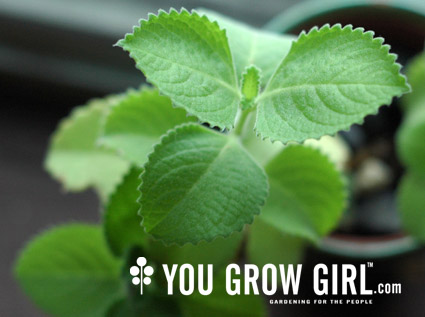Loads of gardening articles and books proclaim that it is easy to grow herbs indoors; however, it is my experience, and I bet it’s yours too, that most herbs are fine during the summer months, but many take a real beating towards the last half of winter. The conditions inside a typical North American apartment or house during the winter months are just not very conducive to picky plants. If you’re like me you’re probably doing most of your indoor gardening around south-facing windows that are cold and drafty above with the occasional blast of mega-hot and dry baseboard heating from below. Trying to keep finicky sweet basils and rosemary alive between these two extremes is too much for my self-esteem and my sanity so I’ve opted to accept that the tricker herbs are out until spring and have spent the last few years seeking out and experimenting with herbs that can hack these complicated conditions.

I was given a cutting of Broadleaf thyme (Coleus amboinicus) last summer with the promise that it would root easily and grow like crazy. It has delivered and more! Broadleaf thyme is an unbelievably fragrant, low-growing herb with succulent, broad leaves and a soft, velvety texture. It goes under several names (more on that below) including Cuban oregano, Spanish oregano, and Indian borage but is unlike any thyme or oregano plant (or borage for that matter) you have ever seen. The plant is a tropical perennial and will not survive a cold winter outdoors, but taking a cutting or two to grow in a pot is as easy as snipping off a chunk with a pair of scissors and popping it into some water or moist soil. I offered mine nothing but neglect in the beginning, forgetting about it amidst a boatload of other gardening duties and it STILL grew and flourished. This plant is definitely a trooper!
Grow It: I have found that mine seems to do well in the sunniest spot available. The leaves are still a tad too pale which indicates that it can withstand more direct light. I’ve been growing mine in a standard tropical potting soil with a bit of sand thrown in for extra drainage and a touch of vermicompost at potting time for added nutrition. Like most herbs I add water only when the soil is just dry. Reduced winter light might cause the plant to grow leggy (tall and unhealthy) so be sure to pinch back the top set of leaves (you can use your fingers) every once and while to encourage a bushier growth. Unlike many herbs it will not go dormant so you can keep harvesting the leaves all year long.
Using: Broadleaf thyme has an exceptionally pungent flavor and smell. It is most commonly chopped up fresh and added to black beans or served with fish dishes and curries. I have also heard that it is commonly used in Jamaican jerk seasonings and salt cod. It is used to flavor beer and wine in India and some people put its antibacterial and fungicidal actions to work as a medicinal tea. I tried it this way and didn’t mind it although I found the boiling water brought out the stronger thyme flavor and reduced that hard-to-place fragrant smell that is so strong when you rub the leaves.
The Name Game: Here we go for another round of Name That Plant. I always try and check as many references as possible and cross-check for mistakes so I can give you the correct name but this one is going to take additional research. As mentioned above this plant is not short on common names and is regularly listed under two different Latin names, Coleus amboinicus and Plectranthus amboinicus. Some citations suggest that Coleus amboinicus is the old name, with all names, both Latin and common being interchangeable for the same plant. Others state that Coleus amboinicus is the Latin for broadleaf thyme which has larger leaves and that Plectranthus amboinicus is the Latin for Cuban oregano which has smaller leaves. I honestly can’t find any definitive answers and have decided to offer both options here. I personally lean towards the second option.
I am growing this plant in my apartment. It grew like crazy all winter! I pruned it severely back at the beginning of winter before I brought it inside but now it’s gone wild again. So I don’t think anything can kill this thing.
Richter’s opts for Coleus amboinicus in its description of broadleaf thyme. I’ll have to give this one a try if it does so well indoors in the winter.
I grew it last year summer, but it did not survive the winter indoors. It is one of my favorite herbs. Combine with lemongrass it makes a great winter-comfort tea.
I am new to the gardening world and am wondering if anyone can tell me where I could find some broadleaf thyme. It looks like a great herb to have!
a couple other low maintenance herbs i’ve had good luck with indoors:
*marjoram – such an easy annual to overwinter – plus it tastes good in egg dishes and pasta sauce
*cretan oregano – very ornamental with a spicy oregano scent. ideal for hanging baskets so you can enjoy its unique long-lasting flowers
*bay leaf tree – a slow grower, but fresh bay leaves beat the dried things you pick up in the spice aisle any day. just make sure to place the pot on top of a pebble tray and water from below frequently. they benefit from a little added humidity
I’m in Virginia, USA. Can anyone tell me where I can get Broadleaf Thyme? I would love to plant it in my garden.